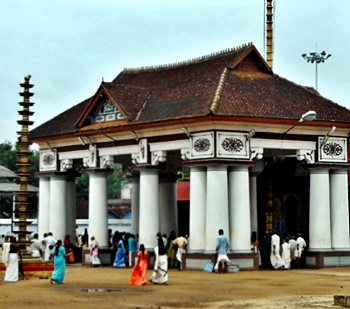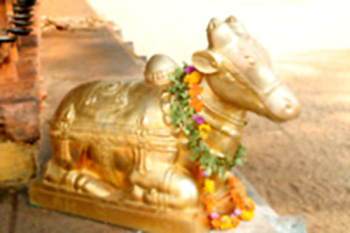 Vaikom Shiva Temple is famous for its benign deity. Life in the little town of Vaikom literally revolves round the deity. It is endearingly called Lord of Vaikom or Perumthrikovilappan or simply Vai-katnappan. His name is always on the lips of devotees. The temple of Vaikom every morning and evening becomes vibrant with hundreds of devotees thronging the shrine with chants of "Nama Shivaya", "Hara Hara Mahadeva", and "Shambho Mahadeva." The life of people here is intimately connected with the deity because he is Annadana Prabhu or the Giver of food.
Vaikom Shiva Temple is famous for its benign deity. Life in the little town of Vaikom literally revolves round the deity. It is endearingly called Lord of Vaikom or Perumthrikovilappan or simply Vai-katnappan. His name is always on the lips of devotees. The temple of Vaikom every morning and evening becomes vibrant with hundreds of devotees thronging the shrine with chants of "Nama Shivaya", "Hara Hara Mahadeva", and "Shambho Mahadeva." The life of people here is intimately connected with the deity because he is Annadana Prabhu or the Giver of food.
Origin of the Vaikom Shiva Temple
The Vyaghrapuri Mahatmya of the Bhargava Purana alludes briefly to the history and divinity of the deity of Vaikom. Khara, and asura of the Ramayana, attained Yogic powers through years of severe penance. At the instance of `Malyavan` the preceptor of the asuras, he propitiated Nataraja at Chidambaram. Moved by his devotion the God granted him several boons and also three Shiva-lingas.
Khara took hold of the lingas one in each hand and the third in his mouth and journeyed through the sky southward. On the way he was overcome by the weight of the objects he carried and hence was constrained to descend and rest for a while. He set the linga in his right hand at a sacred spot, knee-deep in water. After a while he resumed the journey and tried to remove the linga but it would not move although he tried hard to remove it.
At this juncture, Saint Vyaghrapada appeared on the scene. Khara was waiting exactly for this. He entrusted the linga to the care of the saint and proceeded to Ettumanur, 25 km away, where he installed the left-hand linga. The one in the mouth was deposited at Kaduthuruthy, midway between the two places.
 Thus the three spots namely Vaikom, Kaduthuruthy and Ettumanur were sanctified simultaneously. It is also believed as stated in the previous chapter that darshan at these places on the same day is highly auspicious.
Thus the three spots namely Vaikom, Kaduthuruthy and Ettumanur were sanctified simultaneously. It is also believed as stated in the previous chapter that darshan at these places on the same day is highly auspicious.
Legend of Vaikom Shiva Temple
The installation of the idol and the construction of the temple are attributed to Parasurama, an incarnation of Vishnu who, as is now well-known, had consecrated several temples sacred to Lord Shiva and Lord Vishnu for the spiritual well-being of the people of Kerala. One day while being borne northward his eyes chanced upon the beautiful linga at Vaikom, radiating glory all round. Overwhelmed with joy he descended to the spot and embraced the linga in knee-deep water.
He raised a square platform by heaving up earth and installed the linga on it according to Sankarshana rites. It is on this square that the present temple stands. The platform is about 2 feet in height and the linga itself is about five feet.
Parasurama also brought Brahmins for the performance of puja and established the various rites to enhance the divinity of the idol. It was he who also arranged (or the conduct of the Ashtami festival. It is enjoined that whoever offers a bilwa leaf or a coin or a lamp on the day is liberated in this world and the next.
Architecture of Vaikom Shiva Temple
The temple of Vaikom appears flawlessly finished. The temple is elliptical. It is topped with a cone-shaped roof that is absolutely geometrical, covered with copper and crowned by a dazzling gold stupi. The height of the tala or wall is barely one-third that of the colossal roof. And the total effect is one of pure form in space.
The linga is decorated with flower garlands and rare jewels including Trinetras or Siva`s three eyes and crescents. In the glare of hundreds of oil lamps that are lit the idol radiates splendour and provides an eye-filling sight. The walls of the temple are filled with extensive bright colours. The Vaikom temple is a good specimen of indigenous style of temple-architecture of the sixteenth century.
 In front of the garbhagriha is a raised platform or the mtikhamandapam, square in form, where the image of Nandi (Bull) is placed. Beyond it are corridors or pillared halls all round the sanctum and the mukhamandapam. The whole edifice is rectangular in shape and on its exterior has columns of lamps-vilakkumatam-formed on a wooden framework covered with steel trellis works.
In front of the garbhagriha is a raised platform or the mtikhamandapam, square in form, where the image of Nandi (Bull) is placed. Beyond it are corridors or pillared halls all round the sanctum and the mukhamandapam. The whole edifice is rectangular in shape and on its exterior has columns of lamps-vilakkumatam-formed on a wooden framework covered with steel trellis works.
The temple faces east and in front there is a covered shed known as Anakottil where the elephants take their stand in line for the temple procession. The 317-foot-high gold-covered flagstaff is also based here. And beyond it is the circumambulatory path paved with stones for taking the image of the God in procession round the temple.
The uttupura or the feeding shed is on the northern side and beyond it is the temple-tank. The area of the entire temple is nearly eight acres. There are four gateways one on each side but they are not imposing like other temples in the South. There are three or four majestic peepal trees in the courtyard, which add to the scenic beauty.
Three Aspects of Lord Shiva in Vaikom
The Lord Shiva of Vaikom assumes three aspects during the day. In the morning up to panthirati pooja he is Dakshinamoorti giver of divine wisdom to all sages and saints. He is the ultimate knowledge in human form jnana swaroopa. Hence worshipping him at this time one obtains wisdom and intellect.
In the noon upto uccha pooja, he is in the form of Kirata hunter fighting with his greatest warrior devotee Arjuna to test him if he deserves the weapon-the Pasupata astram. This is propitious for bathing the deity and those who want success in anything obtain it by worshipping him now.
In the evening the Lord is Satchidananda itself the ultimate goal of every devotee, be he an ascetic or a householder. The Lord is immersed in bliss, ananda, in the embrace of his consort Parvati. Everybody can freely approach him at this time and obtain his blessings.
Pananchikkal Bhagawati of Vaikom Shiva Temple
On the southern side of the temple courtyard there is a small shrine for Goddess Pananchikkal. This is a Vana-Durga exposed to the sun and rain and as such without any roof.
Once there was a Yakshi (demi-goddess of evil aspect) roaming in the temple premises, harassing humans and animals. The terrified people approached Vyaghrapada Maharshi for protection. The sage turned to Stambha Vighneswara on the north-eastern side of the temple at the entrance. There is another image of Ganaapti inside the temple.
Vighneswara cast a significant glance on Trisuli, on one of his attendant bootaganas. Trisuli, meaning literally three-pronged dragger, cut the woman into three pieces. The trunk was thrown on the southern side of the temple where the shrine stands, the head, at Muthedathu Kavu, 4 kilometres away, and the legs at Kuttummel to the north of the temple. From these the respective goddesses arose.
The Yakshi in a previous birth had been a Gandharva damsel, by name, Neelakuntala. Conceited by her personal beauty and charm she once mocked at Sage Agastya and his disciples returning to their ashram after worshipping Vaikathappan. The enraged rishi cursed her as a result of which she became a Yakshi. She begged forgiveness and was promised liberation at the hands of Trisuli.
Festivals of Vaikom Shiva Temple
Several festivals are celebrated in the Vaikom Shiva Temple throughout the year. But the most important festival of the temple is the annual Ashtami Festival celebrated in the month of Vrischikam.











